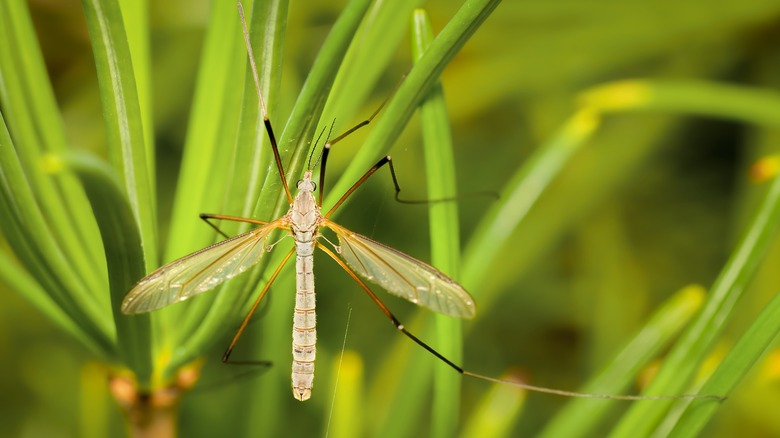Spring Is The Perfect Time Of Year To Treat Your Lawn For This Pesky Pest
Whoever coined the phrase "the grass is always greener on the other side" may have had a crane fly larvae infestation. These pesky pests lurk under the soil where they gorge on your grass and turn your lush lawn into a patchy plot of ugliness. But with a bit of vigilance and preventative care, you can keep these insidious insects at bay and maintain a verdant lawn that makes your neighbors green with envy.
Crane flies, sometimes called mosquito hawks, are fragile-looking insects with long spindly legs and slender bodies. Although they look like monster mosquitos, adult crane flies are harmless and will not bite you. There are approximately 1,500 species of crane flies in North America, and the larvae of most of these species feed on decaying organic matter, making them critical members of the ecosystem's waste management crew. However, the larvae of two invasive species — the European crane fly (Tipula paludosa) and marsh crane fly (Tipula oleracea) — are more inclined to fresher fare. To them, a luscious green lawn looks like a self-service smorgasbord. Fortunately, there are a few steps you can take right now to keep them from gobbling up your grass.
How to identify and thwart crane fly larvae
Invasive crane flies are most common in the northwestern and northeastern United States. The two species have slightly different life cycles. European crane flies lay eggs in early September, which develop into larvae in about a week. The larvae feed on grass in the fall, then remain underground until they reemerge in the spring for another grassy feast. In contrast, marsh crane flies lay eggs in the fall and early spring. The larvae of both species — which are called leatherjackets due to their tough, brown exoskeleton — feed on the roots, crowns, and blades of grass plants.
Maintaining a healthy lawn is the best way to prevent infestation. Healthier grass with vigorous roots can endure larvae damage better than weaker, undernourished grass. Applying nitrogen fertilizer in early spring can reduce the risk of unexpected impacts to your lawn. Aerating your lawn allows water and nutrients to penetrate deeper into the soil, promoting root development. Larvae thrive in wet environments, so avoid overwatering and make sure your soil drains quickly.
Patches of yellow-brown grass are a common sign of larvae infestation. If you suspect your lawn is infested, dig up a square foot section of sod and turn it over to check for larvae. Leatherjackets are grayish green to brown and about an inch long. Their segmented bodies have no discernible heads and small spikes on their hind ends. Healthy lawns can withstand 25-50 larvae per square foot without sustaining much damage.
How to treat your lawn if you find crane fly larvae
If you find larvae in your lawn, you can rake them up when they emerge at night to eat grass blades. Since birds are natural predators of crane fly larvae, you can also hang feeders and birdhouses to attract them to your yard. Chemical treatments are often unnecessary, and many pesticides that target larvae also kill beneficial organisms like honeybees and earthworms. If you opt for a chemical treatment, check the packaging for the best application times. Research suggests some pesticides — like chlorantraniliprole and carbaryl — are more effective in the fall when young larvae emerge from eggs. Dinotefuran, clothianidin, and imidacloprid can be applied in early spring. Neem oil, which contains azadirachtin derived from neem tree seeds, is a possible natural remedy for keeping larvae at bay.
Biological treatments, like nematodes and entomopathogenic fungi, also kill crane fly larvae. Nematodes (Steinernema carpocapsae and Steinernema feltiae) can be applied in the spring or fall. These microscopic roundworms infect the larvae with deadly bacteria before eating them. Some filamentous fungi, like Beauveria bassiana, may also suppress infestations if applied in early spring. The fungi form a dense, white coating on larvae, eventually killing them.
While treatments help contain larval infestations, ongoing lawn maintenance reduces the risk of reoccurrence. Maintenance takes extra time, but it's less work than replacing an infested lawn. Plus, the effort will be worth it when you get a green thumbs-up from your envious neighbors.


